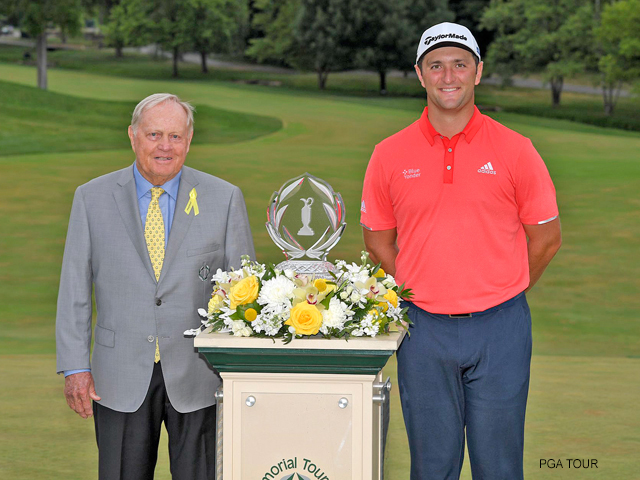 Jon Rahm’s chip-in on the 16th hole Sunday at the Memorial Tournament all but clinched his victory and was described variously as “masterful” and even “Seve-like.” However, PGA Tour rules officials said his ball moved prior to the chip and assessed a two-shot penalty which reduced the 25-year old Spaniard’s margin of victory from five strokes to three.
Jon Rahm’s chip-in on the 16th hole Sunday at the Memorial Tournament all but clinched his victory and was described variously as “masterful” and even “Seve-like.” However, PGA Tour rules officials said his ball moved prior to the chip and assessed a two-shot penalty which reduced the 25-year old Spaniard’s margin of victory from five strokes to three.
It was clear Rahm did not intentionally move the ball, no one says he did and in fact from his reaction during the post round interview when told of the penalty he had not even realized what had happened. All the furor from pundits and fans centers on the fact only by an examination of an extreme closeup video could the change in position of perhaps a quarter of a dimple be detected.
The 2019 modifications in the Rules of Golf incorporated a Decision 34-3/10: Limitations on Use of Video Evidence that would seem to cover the Rahm situation but evidently not in the minds of PGA Tour officials. Here is the wording from the Rule:
“In such situations, if the Committee concludes that such facts could not reasonably have been seen with the naked eye and the player was not otherwise aware of a potential breach of the Rules, the player will be deemed not to have breached the Rules, even when video technology shows otherwise. See also Decision 18/4. In applying this “naked eye” standard, the issue is whether the facts could have been seen by the player or someone else close by who was looking at the situation, not whether the player or anyone else actually saw it happen.”
The decision penalizing Rahm seems to be in direct opposition to the Rules of Golf which uses the double standard of intent and being able to be seen by the naked eye.
Perhaps we need a stronger Rule, the “Rahm Rule,” making application of the “naked eye” standard unquestionable. Of course, the problem is if the player or caddie or anyone close by cannot see a movement measured in millimeters how can any standard no matter how well phrased be applied if closeup video is excluded per Decision 34-3/10 quoted above?
The answer is simple and probably not many will endorse in our argumentative litigious culture. A new rule, the Rahm Rule reverting to the old out of fashion idea golf is a “gentlemen’s game” and place complete trust in the player calling the penalty on himself.
We know change can happen in a positive way and the USGA can respond quickly. Remember the “DJ Rule” which came out of the fiasco Dustin Johnson was brutally subjected to in the final round of the 2016 U.S. Open. Without dredging up all the painful memories, the USGA conceded DJ’s penalty was from applying the standard he had moved a ball on the green “more likely than not.” The Rules were rewritten to remove what in effect was a 51 percent certainty to a realistic “the player will be found to be the cause only when it is known or virtually certain (meaning at least 95 percent) to be the case.”
Golf is a grand game at every level and tainting a performance such as Rahm’s with unnecessary complications and penalties is out of place. Golf calls for a standard of behavior and even if it sounds old fashion the standard is that of being ladies and gentlemen.
Our society may belittle the idea, but character still counts, and the Rahm Rule should work. It used to.
Arnold Palmer said it best, “Golf is deceptively simple and endlessly complicated; it satisfies the soul and frustrates the intellect. It is at the same time rewarding and maddening – and it is without a doubt the greatest game mankind has ever invented.”
